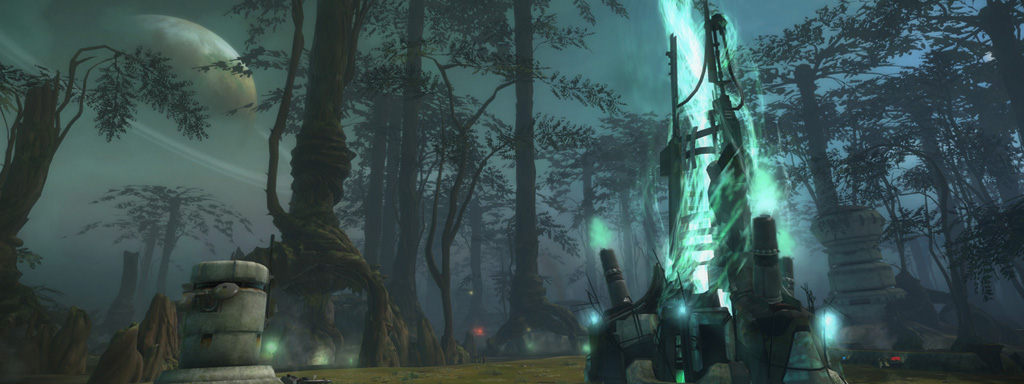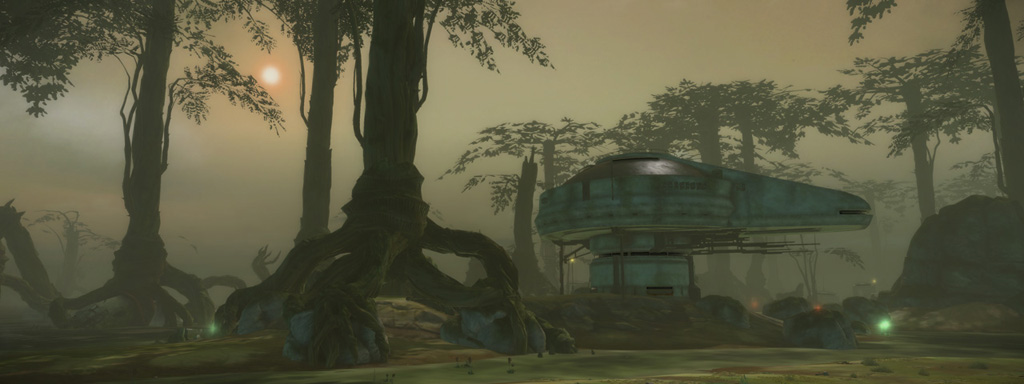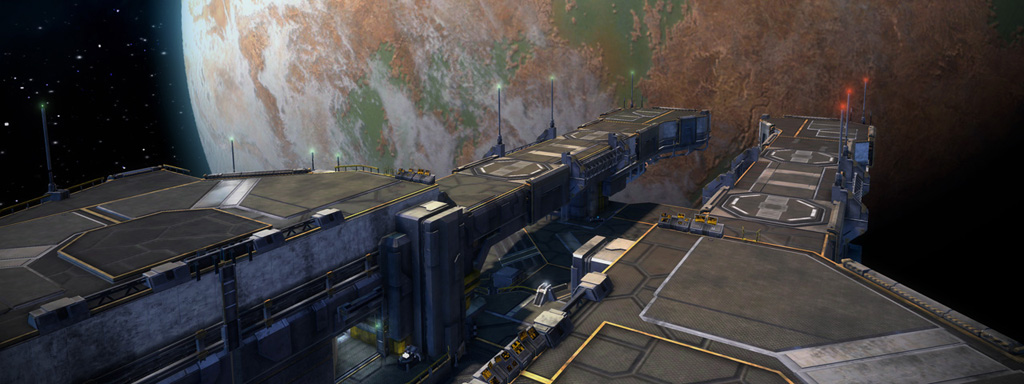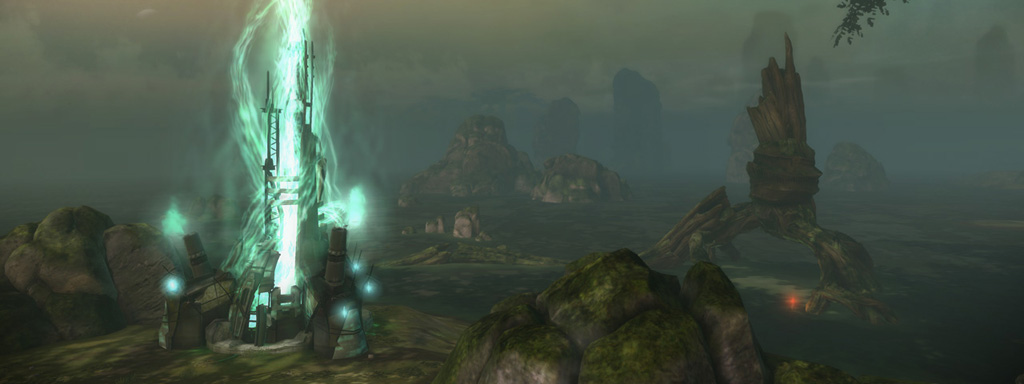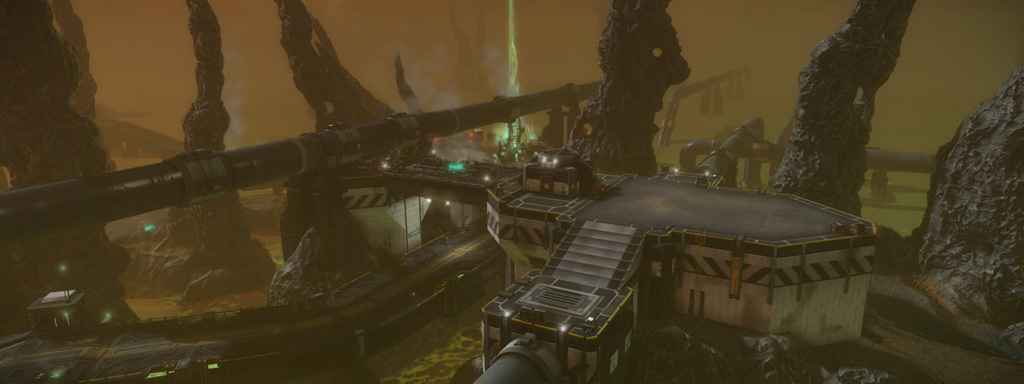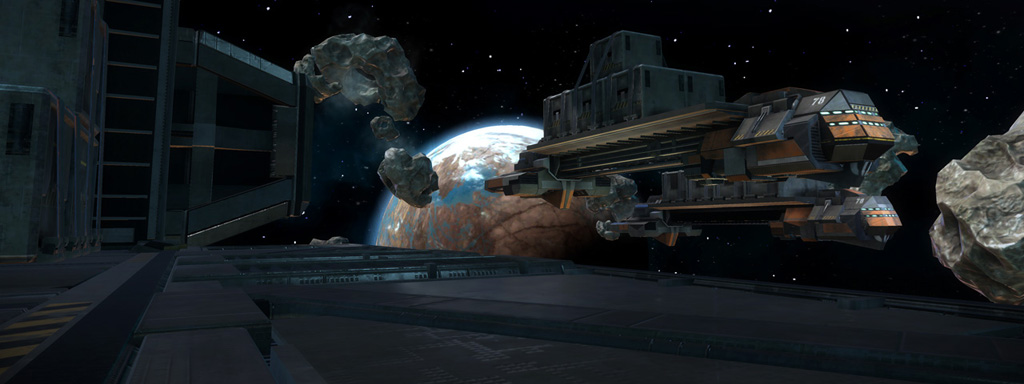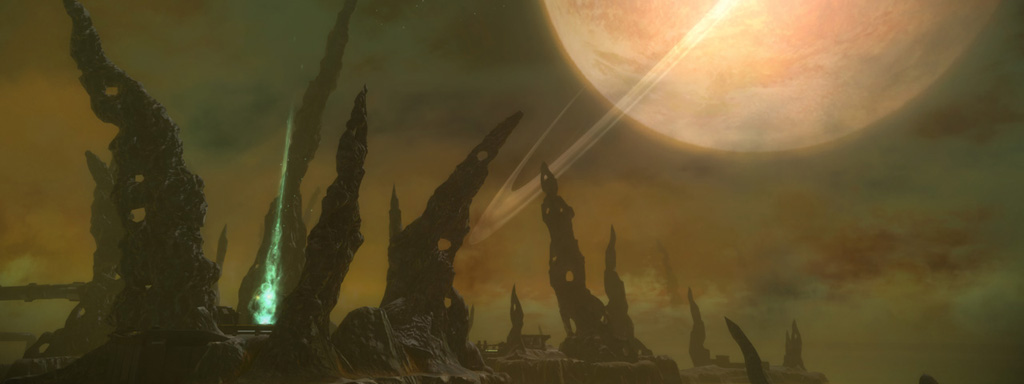Origin
Origin is the first map we developed in the new swamp-themed Cypress environment, released in August 2012 with Starhawk 1.03. Where Starhawk's original levels focused on rift mining and the conflict between Rifter and Outcast, the Cypress theme centers on abandoned and overgrown facilities where research teams first discovered the potential of harnessing rift energy.
Cypress terrain was constructed much like our Sever levels, with a sheet of World Machine terrain broken up into individual islands. This time I was very conscious of the terrain scale issues from before, and focused on laying out much smaller islands to assemble these layouts. The smaller scale helped keep the level's size in check (Origin is closest in size to Outlands), and helped create entertaining routes through the ankle-deep water filling the low-lying areas of the level. Origin also features denser and more chaotic rift placements in Zones, hosting six rifts in a relatively small space.
The Cypress theme is also something of a reaction to player complaints about a lack of cover in the original ten maps. The Extractor prototype and a couple nearby overlooks provide actual interior-ish space for troops to hide from vehicles, while the massive tree roots help create additional pockets of on-foot gameplay and on a larger scale frame some of the intended vehicle routes in the absence of proper "roads." Even the towering tree canopy does its part, shielding areas of the ground from Hawks while Hawks themselves benefit from weaving between the trees and through their branches.
Starhawk
August 2012
Layout
Andrew Weldon
Environment
Matthew Breit, Jon Galloway, Jonathan Lindblom, Stephen Daniele
Collider
Collider is the larger of the two Cypress levels released in Starhawk 1.03, slotting in between Narrows and Basin on the size chart. Like Origin, Collider uses denser rift placement for the Zones mode, hosting a total of eight rifts.
The collapsed supercollider circling the center of the map was something of a happy accident; due to a communication breakdown I was building the level with no idea that these assets existed until they were sent over in a near-finished state. After the initial shock, I worked with the artists on a few tweaks and was able to integrate them into the layout—the collider ring provided a fantastic (and pretty cool looking!) refuge for troops near the midground, and helped provide a little extra character that this map needed. It only seemed appropriate to name the level after it.
At Starhawk's launch, the multiplayer levels contained a minimal set of weapon pickups to encourage players to supply their own weapons and outposts via the Build & Battle system. I worried that this wouldn't be enough to drive player navigation through the maps; these fears were confirmed when players complained of barren expanses with nothing happening. In response, I placed much denser pockets of weapon pickups into the Cypress maps. Players loved the change, more action developed around the new item clusters as expected, and the positive response cleared the way for me back and greatly increase the pickup density in the original maps for the 1.04 update.
Starhawk
August 2012
Layout
Andrew Weldon
Environment
Matthew Breit, Jon Galloway, Jonathan Lindblom, Stephen Daniele
Relay
Relay was the first of three "extra-small" maps developed for Starhawk 1.04, released in September 2012. These levels were designed with smaller player counts in mind, and also were the initial proving grounds of our resurrected Deathmatch mode that also saw release in 1.04.
I first started poking at Relay during some downtime shortly after Starhawk launched; the space environment was easy to get up and running in new layouts due to its extremely modular nature. I started with the core of the level and the twin arms extending out over the midground (invoking some of Apogee's stylings) mixed with a dash of a tuning fork and some inspiration from Homeworld's Bentusi ships.
As the layout came together, I ripped out what had been a solid structural backing to extend the arms across the entire level; this created a clear dividing line down the middle of the layout. In between the new back arms came my new favorite touch - two small troop-scale ledges, each with Auto Turret snap points, designed to intercept pesky Jetpacks trying to take a shortcut across the level.
Starhawk
September 2012
Layout
Andrew Weldon
Environment
Jonathan Lindblom
Glade
Glade reprises the Cypress theme in "extra-small" form. The layout is extremely simple, with bases arranged on a back ridge ramping down to a low-lying midground cluttered with tree roots and low cover. Glade steals the mantle of fastest Starhawk level from Outlands and also served as the most frequent proving ground of the Grizzly Rig DLC vehicle during its development.
One of my favorite touches in the Cypress skydomes was a cluster of rock pillars painted into the back of the skydome. This always gave me images of what a level might look like set there, and invoked immediate thoughts of Warhawk's classic level Archipelago. In the absence of doing such a level, I used stacks of the rock meshes we already have to emulate that style at Glade's outer boundary, giving the appearance of rock monoliths gradually rising from the swamp.
Starhawk
September 2012
Layout
Andrew Weldon
Environment
Jon Galloway, Stephen Daniele
Junction
Junction was the final "extra-small" level developed for Starhawk 1.04. I had originally wanted to try and create a much more structural Acid Sea-styled Deathmatch map, but sadly by the time we got around to making this level, no content support was available and I had to build the level with existing content, including terrain islands used in the campaign mission "The Pit."
While I couldn't manage a much more vertical tower I had envisioned as this map's centerpiece, I still centered the level around a tall man-made structure. Reaching the upper level requires Jetpacks, Hawks, or the Pod Launcher DLC part, making for a particularly intense experience holding or assaulting the upper platform in Zones. The bridge extension from this platform contains troop-scale cover, allowing players to make a more protected Jetpack ascent and fight their way across on foot.
Starhawk
September 2012
Layout
Andrew Weldon
Environment
Jon Galloway, Stephen Daniele
Flotilla
Initial rumors of Starhawk often centered around the "Warhawk in space" interpretion, which actually played a role in my early interest in LightBox. While I was able to scratch some of my classic space sim itch with some of my work on the campaign missions "The Freightway" and "Harvest Season," our multiplayer space maps had to provide ground traversal to support all modes and never really delivered classic space dogfighting.
Immediately after Starhawk shipped, I decided to remedy that. I started by stretching the giant "space train" across the middle of the level, then added nearby clusters of freighters. Once these were in place, I went all-out on the asteroid field motif, with emphasis on creating clusters to steer players towards pickups and encourage certain chase routes. Flotilla is by far the largest level in the game, making it ideal for hectic dogfights on packed servers.
Flotilla truly shines in the new-to-1.04-update mode Gatekeeper, which I designed with tech designer Delvin Mason. The outer rings of asteroid clusters serve as perfect placements for the gates players fly through during the mode, which further emphasizes exciting chases and maneuvering as players try to rack up extended gate runs for maximum points.
Starhawk
September 2012
Layout
Andrew Weldon
Breaker
Breaker, like Flotilla, is a flight-only level released in Starhawk's 1.04 update. Once again, I was limited to existing assets - the skydome hails from the campaign mission "The Pipeline" and the terrain islands are actually the same re-purposed islands used in Junction.
Breaker's layout is divided into three different regions: low-lying open water with loosely scattered spires, clusters of overlapping pipeline, and elevated islands with towering spires. In the absence of a unique set piece, this gave the level some much needed visual distinction between areas and helped keep the flight space varied and interesting, which also shines in the new Gatekeeper mode.
Starhawk
September 2012
Layout
Andrew Weldon
